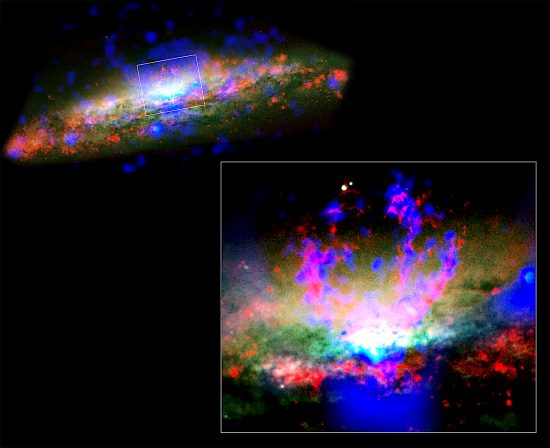
Nov 19, 2019
Galaxies are alive with lightning flashes.
“Bring in the bottled lightning, a clean tumbler, and a corkscrew.”
— Charles Dickens
On Earth, a primary electric discharge channel is called a lighting bolt. In slow-motion, it is easy to see that each flash is a complex series of events. Leader strokes descend from the clouds; usually they are negatively charged. Similar, almost invisible potential contacts rise from the tips of objects below the storm clouds. Once the two strokes meet, electrical energy stored in the cloud-to-ground capacitor discharges, drawing current from several cubic kilometers.
Cloud-to-surface lightning is accompanied by transverse electric discharges, otherwise known as, “corona discharges”. Those regions of charge flow occur at right angles to the primary channel. They look like “tributaries” joining the primary discharge. Surface lightning forces close tributaries to be parallel because of electromagnetic forces between them. Brachiated burns or cuts in various materials at different scales are sometimes called “Lichtenberg figures”.
Lichtenberg figures are named after Georg Christoph Lichtenberg. They form when lightning bolts strike some material on Earth – it can be soil or even human tissue. They are also artificially generated in blocks of acrylic plastic. Many Lichtenberg figures are seen in the south polar region of Mars.
To understand the connection that plasma formations in space have with laboratory experiments, the scalability of plasma phenomena must be considered. Plasma discharges can produce the same formations irrespective of size. Patterns appear in laboratories, on planets, around stars, and inside galaxies. So-called “streamers” were seen inside the shell of gas and dust that made up the haze around the nucleus of Comet 67P/Churyumov-Gerasimenko. As discussed in previous Picture of the Day articles, the braided filaments are the sign of helical Birkeland currents.
Duration is also directly proportional to size. Sparks lasting two or three microseconds in the laboratory might scale up to decade-long events at stellar scales, or millions of years at the galactic scale. Filamentary shapes exist no matter where investigators search. Forces exerted by electrified plasma contained in the twisting filaments of Birkeland currents dominate the Universe. They flow in a cosmic circuit that comes into our field of view and then goes back out into the void with long-range attraction between them.
In the image at the top of the page, NGC 3079 also displays streamers of material moving away from its equatorial plane at right angles. Could it be that corona arc discharges, an electrical phenomenon associated with terrestrial lightning, are occurring on a thousands of light-years scale?
Stephen Smith
The Thunderbolts Picture of the Day is generously supported by the Mainwaring Archive Foundation.












